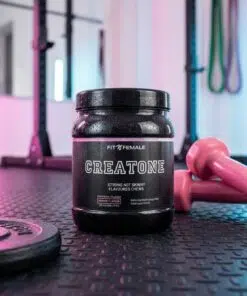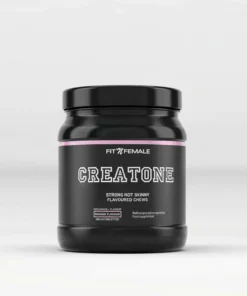The realization that strength training also has many advantages for us women and does not turn us into muscle mountains bursting with testosterone has fortunately spread. And so it is now also more and more women who find the motivation to go to the iron and use the resulting benefits. The problem with this, however, is that unlike the men of creation, we have significantly fewer anabolic hormones such as testosterone in our blood, which means the Muscle building more difficult, of course. But that doesn't mean it's impossible to build muscle, it just becomes a little more challenging. To make this challenge easier for you, you should take the following 8 tips to heart - then it will also work with the muscle building.
Tip 1 - Eat enough
If you want to build muscle, it's important to get rid of the "eat only as much as you absolutely need" mentality, because you won't gain an ounce of muscle that way. Of course, this is difficult to implement at first, because we want to avoid building up fat unnecessarily. That's why it's especially important to eat not only enough, but also the right kind of food. Excessive amounts of sweets, pizza and burgers are not effective. One approach that is both effective and easy to implement is called IIFYM (if it fits your macros) and says that you only need to make sure that your macronutrient needs are met. It doesn't matter whether the protein comes from meat, fish, dairy products or legumes, as long as it's enough. In second place comes the fine tuning.
Tip 2 - Put together a good split workout
First of all, there is nothing wrong with a full body workout, quite the contrary, because especially in the beginning you can achieve excellent results in terms of muscle building. But as soon as it doesn't really want to progress anymore, you should make a split training out of your whole body training, in which you train different muscle groups on different days. Compared to the full body training you have the advantage that you can train each muscle group such as the legs, the back, the shoulders or the chest much more intensively, so that the stimulus for muscle building is greater. How exactly you divide your split is up to you and your preferences. The following splits, for example, have proven successful:
- Two to four workouts per week: push/pull split (one workout day only pull exercises, the other day only push exercises)
- Two to four workouts per week: upper body/lower body split.
- Three workouts per week: legs/push/pull
- Four workouts per week: chest and triceps / back and biceps / legs / shoulders and abs
Experiment around a bit to find out which split suits you best.
Tip 3 - Do less cardio workout
To achieve a sufficient calorie surplus, it is often not enough to simply eat more. Especially if you do a lot of cardio training anyway, you may burn so much energy that there is not much left for muscle building. So it's obvious that you should also cut down on the one or other training session in order to reach your goal, because every calorie you burn on the treadmill is not available to your body for muscle building. Instead, invest your energy in a few extra sets of squats.
Tip 4 - Train with heavy weights
To get the muscles to grow, it is important that you stimulate the target muscles as much as possible. The best way to do this is to use the heaviest weights possible so that the majority of the muscle fibers have to be activated for the movement. In practice, you should choose a weight with which you can do at least eight, but no more than twelve, technically absolutely clean repetitions per set in order to achieve optimal results. Be aware, however, that success does not come overnight. Give your body time to adapt to the challenges and increase the training weight slowly. Nevertheless, you should try to increase with each workout, even if you only manage a single repetition.
Tip 5 -Pay attention to your technique
As you perform endless repetitions with light weights, it's easy to get the technique of each exercise wrong. But this is fatal as soon as you start using heavier weights. On the one hand, the wrong technique can easily lead to serious injuries. On the other hand, the target muscles cannot be optimally stimulated. It is therefore important that you look carefully at the technique of each exercise and, if in doubt, have it explained and monitored by a trainer so that you can use it safely. This is the only way to improve intermuscular coordination and stimulate as many muscle fibers as possible, ultimately encouraging them to grow.
Tip 6 - Treat yourself to protein rich meals
Your muscle build-up stands and falls with the protein supply, because without sufficient protein even the best training is useless. Accordingly, it is important that you eat at least a little protein with every meal of the day to ensure the continuous supply of your body. This rule applies not only to the main meals, but also to the snacks in between. To give you a little orientation on how much protein you should eat throughout the day to build muscle, multiply your body weight in kilograms by a factor of 1.5. The result is your daily protein requirement in grams, which you should ideally divide into 5-6 meals.
Tip 7 - Take your rest days seriously
The great thing about fixed training plans for muscle building are the scheduled rest days where you can rest with a clear conscience. The downside, however, is that sometimes you just don't feel like taking a break because it feels like a step backwards. That's one of the biggest mistakes you can make, though. That's because your muscles don't grow while you're working out, they grow during the rest periods between workouts. So make sure you give each muscle 48-72 hours to regenerate and build new muscle structure. You don't have to stay completely inactive, though, because active recovery like cycling or swimming is beneficial for blood circulation and thus also positive for nutrient supply and muscle growth.
Tip 8 - Train until muscle failure
On the Internet, you will certainly read again and again that you should train to muscle failure in order to optimize the training stimulus. There's nothing wrong with that in principle, but muscle failure doesn't mean that you push your muscles to their limits with all your might and neglecting the technique. Rather, it's not about absolute muscle failure, but technical muscle failure. This means that you control the load so that you can just manage the last repetition of the set with clean technique. As soon as you can't do another clean repetition, you stop the set. In terms of stimulation, this is much more effective.
CreaTone Chews
CreaTone are creatine chewable tablets with 1000mg creatine monohydrate and orange flavor. By taking creatine you can increase your performance, especially in the area of maximum strength by up to 20 percent. As a result, the growth stimulus acting on the muscles also increases, which leads to an optimization of muscle building, or in the context of a diet ensures that a large part of the hard-earned muscle remains despite calorie deficit.
CreaTone Chews





